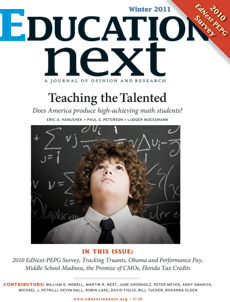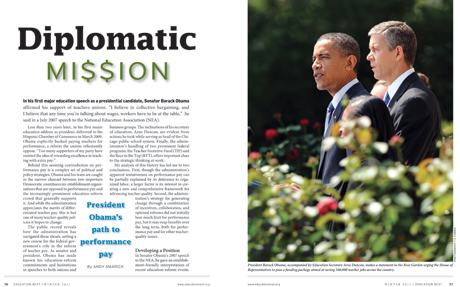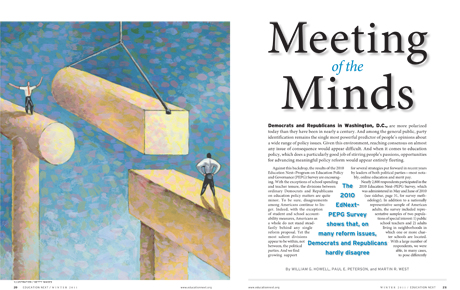As the former president of the Fairfax County Association for the Gifted and a parent of three children who attended Thomas Jefferson (TJ) High School for Science and Technology in Alexandria, Virginia, I was thrilled to see the study that looked more closely at how well the U.S. is (not) doing at teaching math to gifted students (“Teaching Math to the Talented,” features, Winter 2011). Normally, research studies focus on scores for No Child Left Behind assessments, rather than on how much or little academically gifted students are learning.
I’m not sure that your prescription to cure this problem will work that well, though, especially for elementary and middle-school students. At least in areas where there is a critical mass of highly and exceptionally gifted math students, a better solution may be to group them together in a magnet school with unusually rigorous classes that go above and beyond the normal “honors” or “advanced” curriculum. That’s basically what TJ does for 9th- through 12th-grade students, and it works well.
Children, no matter how gifted, often have difficulty with online courses. Some students lack the discipline to do what’s required on a timely and consistent basis. Some students are not technically savvy enough to figure out what they are supposed to be doing. For example, they may have difficulty understanding how to access and turn in assignments.
Further, making rigorous online courses available does not mean that gifted students will be allowed to take them for credit. At least in the Fairfax County Public Schools (FCPS), students generally are not allowed to earn credit for rigorous online math courses offered by organizations such as the Johns Hopkins University’s Center for Talented Youth (CTY), Stanford’s Education Program for Gifted Youth (EPGY), or the Art of Problem Solving. Instead, gifted students are required to take online courses developed by FCPS employees for an academically heterogeneous mix of students.
In some areas of the United States, the logistics of having a magnet school for the highly gifted may be so daunting that online math courses are the best option. In more densely populated areas, however, I believe there is a better alternative. Just restructure gifted programs so that there are enough highly and exceptionally gifted students in one school building, and provide those students with appropriately challenging classes.
Louise Epstein
McLean, Virginia
Differentiating Instruction
I am writing in response to Michael J. Petrilli’s article (“All Together Now?” features, Winter 2011). Many years ago, in my third year as a public school teacher, I discovered that about half of my 7th-grade students read four or more years below grade level, and about half read four or more years above grade level. There were few, if any, students in the middle range. I had to figure out how to orchestrate a language arts classroom that worked for students at a wide range of readiness levels. There were no books on differentiated instruction to guide me.
Once at the university, after 20 years of teaching middle school, I found that many teachers were eager for strategies to help them teach successfully in heterogeneous settings. What I began to write about and to call “differentiated instruction” was rooted in what I learned through classroom practice and now has become more fully developed through observing many other practicing teachers, conducting research, and studying the research of others.
Here are two conclusions that seem solid to me at this point: The idea of homogeneity in a classroom has always been a myth. When educators sort students into those whom we perceive to be capable of learning robustly and those whom we perceive not to be, we are often inaccurate.
Most of the research that is positive about tracking or ability grouping compares two conditions: 1) heterogeneous settings in which teachers do little to attend to student differences, and 2) tracked or grouped classes, where the teacher teaches at the perceived readiness level of the students. There is rarely a third group studied—one in which a teacher differentiates instruction in a knowledgeable way to address student differences.
Teaching with student differences in mind is not easy (although, like virtually all other learned skills, it becomes much easier and more natural with sustained practice). Like students, teachers differ at any given point in skill and will to learn new things. They learn when someone meets them at their point of entry and persistently supports them in moving forward. Practicing teachers who learn and sustain these skills most often do so under the sustained guidance of effective building principals, who provide intelligent, proactive support for teacher growth.
In a nation where “minority” students are already the majority in some school districts, and where they will become the national majority within a few years, we cannot afford the cost, ethically or economically, of “teaching down” to any group of students. We might do well, in fact, to study those schools and teachers that have learned to “teach up.”
Carol Ann Tomlinson
Curry School of Education
University of Virginia
While other public school systems remain paralyzed, ankle deep in the teacher performance pay waters (see “Diplomatic Mission,” features, Winter 2011), Houston’s policy leaders and teachers joined hands and took the plunge years ago. That leap of faith in the idea that schools can’t be truly transformed without great educators in every classroom is now paying dividends.
Each teaching job opening in the Houston Independent School District (HISD) today draws 100 more applicants than in 2006, when Texas’s largest school system began rewarding its best educators with thousands of extra dollars for boosting student achievement.
Good teachers are staying and, the early data show, the ineffective ones are looking for work elsewhere. Nearly 92 percent of teachers who earned bonuses return to the classroom the next school year. On the flip side, only 2 percent of those teachers whose students came up short of our expectations were back on the job in the fall.
Since 2006, the number of Houston schools earning one of the state’s top ratings has more than doubled to exceed 200 campuses, fewer students are repeating a grade level, and more are testing at the highest levels of academic achievement. In high school, more students are passing college-level Advanced Placement exams than ever before.
Teachers here know that our research-based reward system measures the progress individual students make in their classrooms, and educators who do the best job tailoring instruction to meet each child’s specific needs tend to receive the highest marks.
This is why Houston teachers are buying into our system. According to our most recent survey, Houston teachers who said they favor merit pay outnumbered those opposed it two to one. Houston’s experience should make it clear that good teachers don’t want to be treated like the “interchangeable widgets” that, as Secretary of Education Arne Duncan said, they are reduced to under seniority-based pay systems.
Talented, hard-working teachers deserve better. That’s why we’ve partnered with The New Teacher Project, founded by teachers, to overhaul the way Houston’s educators are evaluated and rewarded. When this multimillion-dollar initiative is finished, HISD will have the nation’s best system in place for recruiting teachers, judging their performance, training them to overcome their shortcomings, and promoting the best ones into jobs where they can have the most impact.
Terry B. Grier
Superintendent of Schools
Houston Independent ?School District
Sitting where I do, in a progressive think tank, my perceptions closely track those of the Education Next survey and the authors’ conclusions (see “Meeting of the Minds,” features, Winter 2011). Indeed, as an education reformer, I find the survey encouraging. I would like to see Congress move ahead with the Elementary and Secondary Education Act (ESEA) reauthorization and take steps on most of the core issues addressed in the survey.
I do have two quibbles. First, under a heading titled “Student and School Accountability,” the authors discuss student accountability only. Were there any questions about school accountability? The consequences of chronic, low-level, school-wide student performance are very controversial. The issue of school accountability overshadows student accountability, which is probably why student accountability gets little attention.
It’s also not fair to paint elite politics or teachers unions as the main opponents of accountability requirements. Local community members in neighborhoods surrounding low-performing schools have been quite boisterous in opposing school closures and massive teacher transfers and they have conveyed their views to their representatives in Congress. At the same time, the poll results seem to show that these communities strongly support school choice, charters, and tax credits. These options have not been successful enough for the communities with the most troubled schools. For example, there are rarely enough schools within a reasonable travel distance for their children to transfer to.
My second quibble is with how the question on teacher tenure seems to have been asked. There is a difference between opposing tenure and favoring tenure reform. Were any questions asked about tenure reform? Randi Weingarten [president of the American Federation of teachers] is in favor of it!
In general, I agree with the potential for some Republican and Democratic cooperation on ESEA. I would move tenure reform into the list of potential partnership positions. But school spending is another matter. The landmark No Child Left Behind legislation was accompanied by big increases in federal education spending. That seems unlikely in the future, unless legislators agree that well-targeted increases tied to performance results are a necessary part of getting the United States out of its economic doldrums.
Cynthia G. Brown
Vice President for Education Policy
Center for American Progress
Howell, Peterson, and West respond:
We share Cynthia Brown’s interest in the public’s views on school accountability and included a variety of such questions on our previous surveys. Interestingly, the public in 2007 was considerably less supportive of the practice of publishing the average test scores at each school than of requiring students to pass a test to move to the next grade or receive a high-school diploma. Even so, 60 percent of the public supported the publication of test results while only 20 percent opposed it. The complete results of all Education Next–PEPG surveys are available at www.educationnext.org.
Tackling the ?Straw Man Middle School
The two recent articles on middle schools (“The Middle School Mess,” features, Winter 2011, and “Stuck in the Middle,” research, Fall 2010) share an interesting characteristic: They treat the title “middle school” as if it represents a uniform, monolithic method and structure of schooling. I write to challenge the logical fallacy of the “straw man” middle school these articles depict and the negative effects associated with it.
I’ll begin with grade configuration, the criteria used by the authors to define a middle school. National Center for Education Statistics 2005 data reveal that 6th, 7th, and/or 8th graders are found in schools with at least 60 different grade configurations. That statistic alone challenges the use of grade configuration as the defining factor for the straw man middle school. It’s also worth noting that the EdSource study (“Gaining Ground in the Middle Grades: Why Some Schools Do Better,” 2010) cited in “The Middle School Mess,” did not find grade configuration to be a factor in student performance.
A broader definition of a middle-level or middle-grades school is a separate school that serves a group of young adolescents, ages 10–14, in one or more grades. Using that definition, what can the authors tell us about why such schools, in their view, are not successful? The answer is “not much.” For example, the articles do not address the professional preparation of the teachers in middle-grades schools compared to those in K–8 schools, although NCATE’s [National Council for Accreditation of Teacher Education] recent report on teacher preparation highlights the critical connections between teacher preparation and student outcomes.
The articles also do not take up what is happening inside the classrooms and in interactions between and among educators and young adolescents, nor the organizational structure of the schools, nor the policy and community contexts within which those schools reside. In describing middle schools as ineffective without addressing the variability represented among schools with those two words on the sign out front, the authors use a broad brush—some would argue a bucket of mud—to splatter aspersions on every school that educates young adolescents within a distinct structure. This approach seems illogical because, in fact, it is.
Gayle Andrews
President
National Forum to Accelerate ?Middle-Grades Reform





